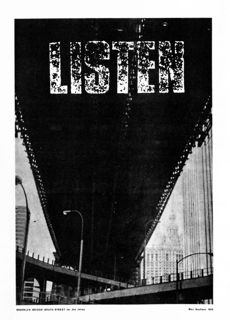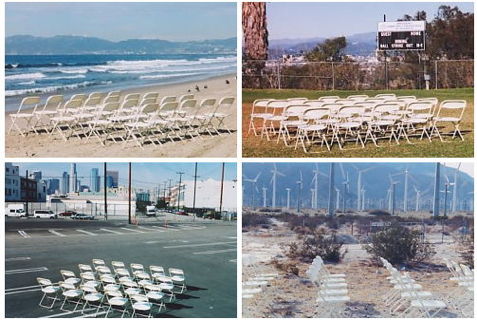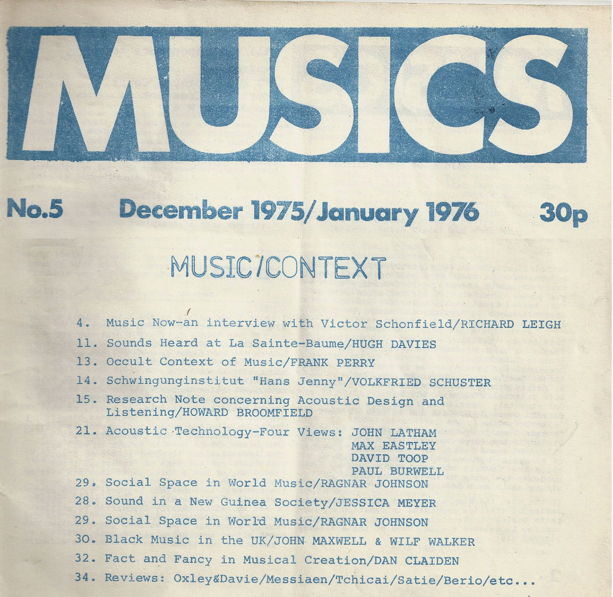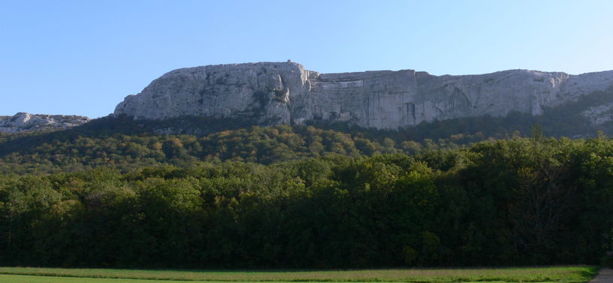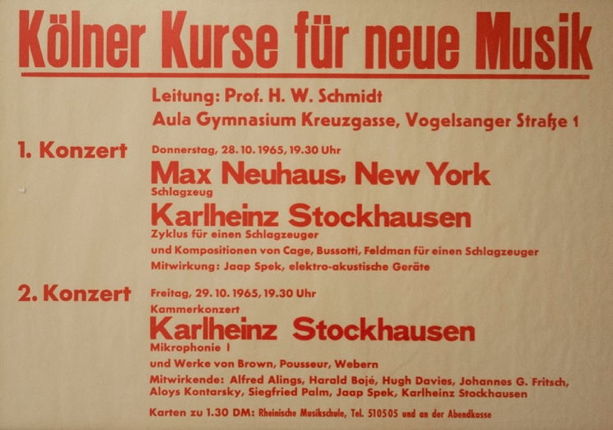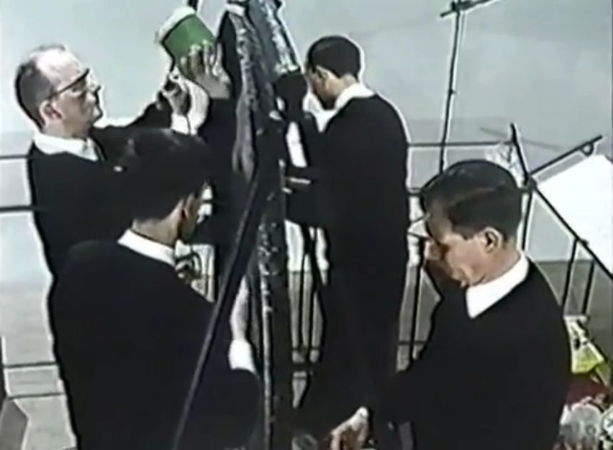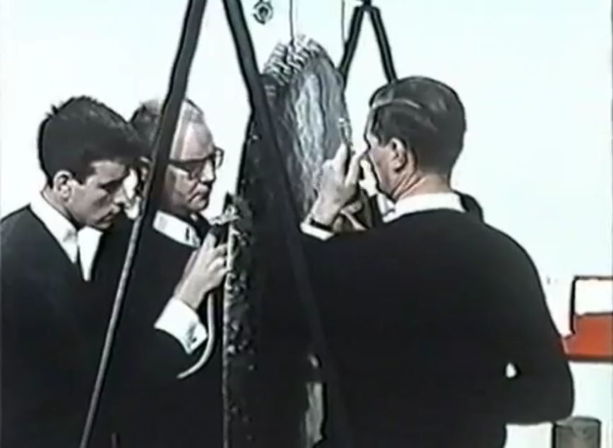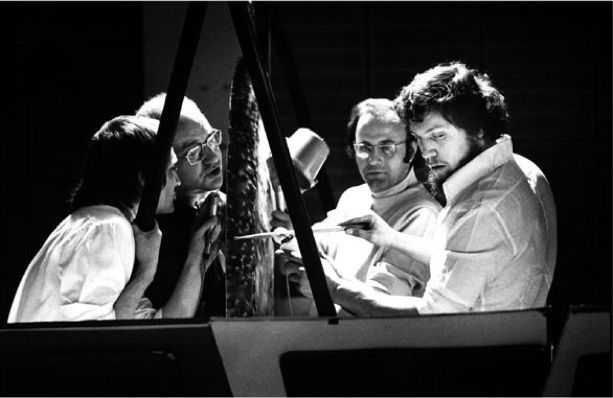| <<<<<<<< prev. — next >>>>>>>> |
|
Publishings/Publications : — ∇ Biblio — ∇ 2014-2011 Texts — ∇ Ph.D. research / Recherche Ph.D. — ∇ Studies / Études |
VISITING, WEAVING, AND MODULATING SONIC EXPANSES AND RHYTHMS — TUNING, IMPROVISATION, AND ENVIRONMENTAL AESTHETICS
VISITER, TRAMER ET MODULER DES ÉTENDUES ET RYTHMES DANS L’ENVIRONNEMENT SONORE — SYNTONISATION, IMPROVISATION ET L’ESTHÉTIQUE ENVIRONNEMENTALE
(Jérôme Joy)Ph.D. student - audio art & experimental music, Laval University Québec (CAN)
Locus Sonus – audio in art, research lab, http://locusonus.org/
Tenured professor at the School of Arts, École Nationale Supérieure d'Art de Bourges, France
joy(at)thing.net, support(at)locusonus.org
03/2015
PhD art audio & musique expérimentale (audio art & experimental music), Université Laval Québec, 2014.
In Symposium #8 Locus Sonus, Audio Mobility, École Supérieure d’Art d'Aix en Provence, École Nationale Supérieure d'Art de Bourges, LAMES MMSH Université Aix-Marseille, Seconde Nature Aix en Provence, Fondation Vasarely Aix en Provence, et Accord-Cadre CNRS / Ministère de la Culture.
In Wi: Journal of Mobile media, special issue, http://wi.mobilities.ca/ , open-access peer-reviewed experimental journal by the Mobile Digital Commons Network (MDCN), lead by the Mobile Media Lab in Montreal, http://www.mobilities.ca/ , and in Toronto, http://www.mobilemedialab.ca/ .
(En cours de publication / forthcoming)
Abstract(Edit)
We shape the environment that shapes us. What we discern as an auditorium and a listening space is now overflowing the specific physical structures and architecture (concert halls, venues, etc.) towards enlarged sensory enveloping forms. It appears as a hybridisation of actions and spaces where tactics such as collective-driven, individual weavings, embedding mobility and spaces/places visits, all contribute to the everyday experience. When we collaborate and oscillate with the environment, within mobility, by modulating and interacting with sonic expanses and continuities of the properties of the places, we listen to more than what we hear. It is not merely a question of positions and of trajectories of presences and bodies in an environment (visual, sonic, animated, landscape, ambiance, venue, concert hall, at home, with earphones, etc.). It is continuous and immediate actions of attention through mobility or of mobilised attention (to act in the now, to be aware of the now), of lithe, flexible, and absentminded exchanges and weavings with the fields of the sensible; of mobile versus immobile reality; of oscillations between the “possible” and the “real”. This generates aesthetics of experiential situations and creative, participative spatialisation experiences in our sonic environment. Thus, we need to explore and to consider a larger notion of auditorium that we are modulating and playing.
Résumé(Edit)
Nous façonnons le monde qui nous façonne. Ce que nous distinguons en tant qu'auditorium et espace d'écoute dépasse aujourd'hui les architectures et structures spécifiques (les salles de concerts par exemple) et permet d'envisager ces notions et les pratiques qui les animent dans des dimensions de l'ordre de formes enveloppantes sensitives et perceptives. Ces aspects et ces opérations présents dans nos expériences quotidiennes, c'est-à-dire dans des mobilités continuelles, couvrent une certaine hybridité comprenant à la fois nos actions et la perception d'espaces. Ils apparaissent comme des nœuds et des tactiques de cheminements, de visites et de trajets à la fois conduits collectivement (avec les co-présents) et individuellement (se frayer un rythme dans une polyrythmie environnante). Quand nous collaborons et ainsi oscillons avec l'environnement, au sein de la mobilité, par les modulations et interactions avec les étendues sonores (les sons qui viennent vers nous) et les continuités perçues dans les lieux traversés, il s'agit d'écouter plus que ce qu'on entend. Ce sont des actions continues et immédiates d'attention, dans la mobilité ou en étant mobilisé, aux échanges et tramages souples, flexibles et distraits avec le sensible et avec la réalité mobile / immobile (les mouvements, les rythmes, et également les oscillations entre le "possible" et le "réel").
Ceci correspond à des situations esthétiques et expérientielles et à des expériences participatives de spatialisation dans l'environnement sonore. Ainsi nous avons besoin d'explorer et d'envisager un plus large auditorium que nous modulons et jouons.
1. Introduction(Edit)
Over the last few years my research has focused on the definition of “auditorium” and how it cannot remain unmodified in this digital and networked age. I propose that it is necessary to explore the subtle difference between what is “producing” an auditorium and what “is” an auditorium. What we discern as a listening space for the production and reception of music and sound – the audio perceptions and experiences that we can have, now largely surpass the specific physical structures and architecture dedicated to audiences and to sound propagation (concert halls, venues, esplanades, etc.). Enlarged and invisible, sensible and sensory enveloping forms are now developed beyond the perimeters of our perception: from environmental ambiances and atmospheres to internet auditoriums and larger invisible listening structures and membranes – as transparent, evolving, and emergent as they are.
We have to examine these “spaces”: their architectural filiation with places and rooms, their plasticity and ductility. Their propensity to be built, planned, settled and landscaped for listening; their ability to locate and seize listeners and to be explored by sound productions designed to be listened to. It is our interest to explore hidden forms of sound and musical structuring “by” space and “by” spatial components: forms, processes and energies of sound spatialisation, immersion and propagation. Propelled by sound intensity, spectrum, phasing, filtering, delay effects, and so on, they involve or emerge from reactions, interferences, and feedback of/with the space. That is why the author is opening several hypothesis that cover musical and sound production and “manufacturing” (music composing, interpreting, playing); reception and perception (the listening); the presence and co-presence in the spaces and places (audiences). This also includes sociotechnical contexts and usages that allow interconnections between sound and musical actions; operations and members of an audience; reactions, responses, and properties of the “listening” space, all being perceived as coherent, seamless, and homogeneous (that is producing an “auditorium”). Rather than conceiving and producing a sound or musical operation as action in time and in space, the act of listening consists of activating a space (in time) and to be conscious of that space.
This research involves what the author considers as an extended “music” for expanded and expanding auditoriums, i.e. an idiomatic music for correlated and “tuned” spaces and for members of audiences attuned to a homogeneous and co-constituted setting or field, as virtual and intangible as it is, in which they consider they are co-present and participating “in space” and “in time”. This also implies the prospective development of a music “by” environment, i.e. based on and structured by impact and feedback of spaces: when music and environment are intermingled, collaborate together resonate and “oscillate”. Thus, as attuned listeners we could explore an idiomatic music and new aesthetic experience based on properties of sound propagation in acoustic-networked, tuned and connected spaces.
It should be understood that the notion of mobility is not at the very core of my research. However, because the auditorium could be considered as a perceived space (the listened to space and the listening space) where sound is propagating with some constraints, thus obtaining certain (acoustic and aesthetic) effects. Because its structure has continuously evolved alongside musical history and the history of architectural listening-buildings – from rooms (where listeners are maintained in a certain disposition) to spaces (where the audience can move, choose a listening point, trajectory or itinerary and visit the space) – plasticity and ductility are now new aspects of what we understand and consider as an “auditorium”, beyond an ideal type of listening space that is conceived of as static in nature. Thus, questions involving the notion of mobility certainly imply modifications of aspects of these auditoriums. To landscape an auditorium, beyond the boundaries of our sensorium (up to what seems and appears to be out of our reach), requires us to map, sound and probe a space, a milieu or an environment, to experiment an immersion and to continuously evaluate a combination of spaces dedicated to the listening and to the organisation of and interaction between listeners. For this paper and in order to examine the question of mobility in listening, I'll call on two examples: works by Akio Suzuki followed by Hugh Davies’s and Karlheinz Stockhausen's approach to intuitive music. I will then propose a brief approach to environmental aesthetics related to “grasping” the environment or fluctuating, flowing and floating element(s), component(s), or propertie(s) in an environment, related to our position and mobility.
2. Visiting and weaving within sonic expanses(Edit)
Akio Suzuki, as a Japanese composer, artist and inventor of instruments, is interested in the use of the echo phenomena that give us a strong sense of place. His performance works play with richly layered and simple resonances, delays, echoes and overtones. While exploring new methods of listening, he is developing various processes of “throwing” and “following” based on the principles of call and echo. These are used to investigate places by constructing a topography of sound, and “taking the natural world as his collaborator” (Suzuki).
Since 1996, Suzuki has been developing a specific work based on listening: Oto-date (echo point or listening point). These works, without using any sound conceived by Suzuki, or while being “soundless”, question both sound perception and musical situation: how can past and mundane experiences of members of the audience reconstruct new experiences in the present instant? Akio Suzuki’s Oto-date plate (a pictogram of human footprints and ears) marks and draws attention to a special place (a chosen spaces of transit). The artist proposes and plans a route by designating and selecting “audial” points located at places with extraordinary acoustic features. These invite the auditor to listen to natural environments, urban space or a building and finally focus on listening to everyday situations.
These works are joined by others such as Max Neuhaus’s Listen (1966-68) and Peter Ablinger’s Listening Piece in four parts (2001). Passers-by are invited to discover a new sensation, perception and emotion – and consequently a new way to inhabit, affect and perceive the surrounding space-time continuum – by staying motionless in an unusual attitude in a specific location over a period time. This intimate understanding of the place puts our body at the intersection of sonic expanses that propagate around us and are within our reach.
A few years ago, during a festival on an island near Hong Kong, Suzuki proposed a collective soundwalk ressembling a procession that started from the shore and went up the mountainside through dense forest passages. Successive sounds of stones banged together by the performer reverberated on the more or less reflective surfaces of the environment, along the narrow path crossing a grassy area, through a small hamlet of houses, then entering an immersive forest canopy. The event by Suzuki simultaneously alters our participation as listeners and our perception of what “music” is made of; between what is receiving and hosting the played sounds (the visual and aural space around) and what constitutes the played sounds themselves (the sonic probes). To play sounds while crossing different spaces (simultaneous sonic expanses and flux that are both fortuitous and particular) corresponds by analogy to a kind of “illumination” and “mobilisation” of successive acoustics which in return respond and react. Our wandering and peripatetic action both follows and shapes the furrow and “groove”; both the path and the way. This creates the impression of a live filtering produced by our continuous mobility and by increasing and decreasing distances, as sounds are emitted and then return, reverberated, echoed and reflected from the surfaces and volumes of the spaces.
In some respects, as noted above, this is reminiscent of the practice of ambulatory lighting as it stimulates, probes and thoroughly explores the acoustic spaces and the sonic expanses beyond what we call the “soundscape” by rendering it unlimited. The interpretation of these perceptible spaces involves seizing the opportunities offered by the moment and the place: what is already there manifested through multiple fragments and variations, like so many coloured and tinted planes and volumes. These kinds of perception profoundly and permanently alter the topography: the road and the landscape are more complex than they at first seemed to be. At the same time, we both lose our way and discover new landmarks in our environment. This art of manufacturing the space through sounding that we propose might be considered as a way of “cultivating” listening and of “weaving” within sonic environments encounters by analogy another artform: shakkei [1]. In Japanese tradition, shakkei (which literally means “borrowed scenery”) refers to the subtle practice of gardening considered as a technique of perception, construction and interpretation of reality (and of collaboration with the outside world) in a composition. Thus this artform where we direct, modulate and adapt our listening, composing with the environment intuitively through improvisation will inevitably remain a partial and meandering listening experience. Nevertheless, this operation has the capacity to profoundly alter our perception of environments – and ultimately of the world – while being immersed in them. This process of building – effectively the setting up of an auditorium – collaborates with the environment and experiments with acoustic expanses, using strategies of minimum and maximum saturation and intensification of acoustic spaces (“merging into the surroundings”); it modifies, our ways of perceiving and enables us to participate, evaluate and modulate “together” the very listening experience that is being constructed.
As Suzuki plays with echoing surfaces and the sound qualities of natural and architectural places, while being immersed in the surrounding environment, this example can help us to have a better approach of how we're playing with our milieux and with co-presents perceived into these milieux (towards a kind of “mesology”[2]). We suggest that these operations, requiring mobility for the production of spatialisation effects, catalyze situations by collaborating with environment and borrowing from distance. They lead us to experiment with expanses and intensities, thereby continuously modulating our own listening situation.
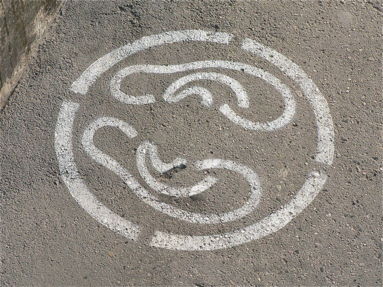 Akio Suzuki, Oto-date, Torino, 2006. Credit : Carlo Fossati for e/static. | 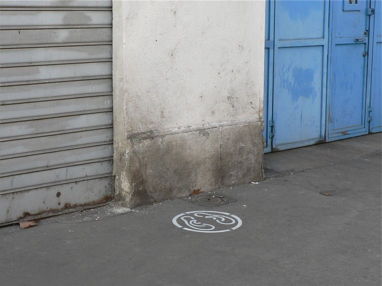 Akio Suzuki, Oto-date, Torino, 2006. Credit : Carlo Fossati for e/static. |
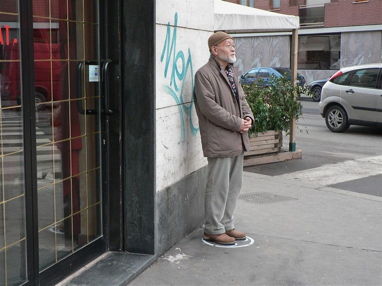 Akio Suzuki, Oto-date, Torino, 2006. Credit : Carlo Fossati for e/static. | 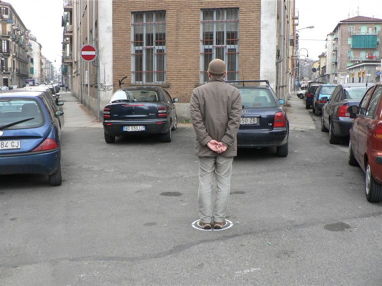 Akio Suzuki, Oto-date, Torino, 2006. Credit : Carlo Fossati for e/static. |
 Akio Suzuki, Oto-date, Sentier des Lauzes, 2004 | 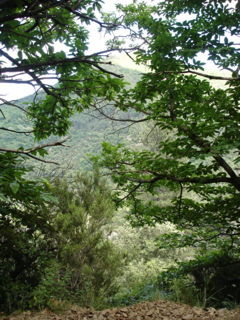 Akio Suzuki, Oto-date, Sentier des Lauzes, 2004 |
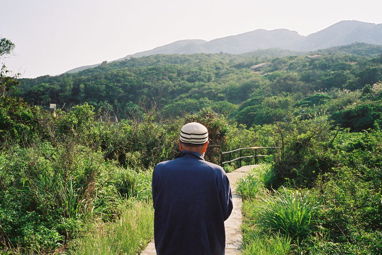 | 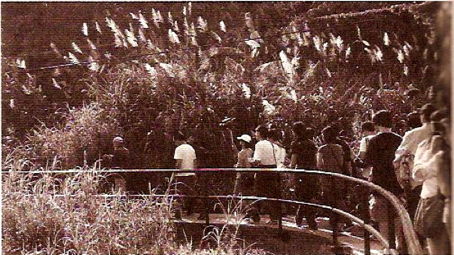 Akio Suzuki, performance, Tung O and Motat village, Soundpocket Festival, Hong Kong, 2009. Credit : Soundpocket, Hong Kong. |
3. Modulating into the environment(Edit)
Sonically modulating and syntonizing with an environment could, arguably, qualify as methods for musical improvisation. We propose to briefly broach notions of intuitive music and environmental music as they were investigated by Stockhausen and Davies. I discovered by chance that Hugh Davies, an English composer who was Karlheinz Stockhausen’s musical assistant and who was involved in numerous musical and art projects in the 1970s and 1980s[3], created a piece in 1974 that took place not so far from Aix en Provence: Sounds Heard at la Sainte-Baume.
Very little documentation about the work remains available and accessible, but referring to a recent paper by Julian Cowley and James Mooney, we can show that Davies realized Sounds Heard in a way very close to Suzuki's performance at Tung O Beach and his Oto-date works:
| “In July 1974 in southern France, English sound artist Hugh Davies [...] wrote Sounds Heard at La Sainte-Baume, a text comprising seven invitations to listen. One advocates standing on the highest mountain peak, listening to the shrill calls of swifts in their rapid convoluted flight. Another commends listening to the loud and varied songs of crickets. The seventh proposes listening to the echoes produced by two stones struck together, in regular rhythms at different speeds, in a small secluded valley high up in the mountains, surrounded by rock on all sides.”[4] |
At that time both Davies and Stockhausen were involved in environmental listening, improvisation and indeterminacy; new instruments, audio art and installations. But my interest today leads me to focus on the notion of intuitive music first developed by Stockhausen and re-interpreted by Davies[5]. To examine intuitive music, its correspondences and differences with free improvisation may help us to distinguish specific manners of deliberated decision making and participations based on interactions, synchronisations and responses when engaging with an evolving sonic environment and organisation of co-presences.
I would like to point out another distinction that can be made within the category of intuitive music this is the difference between a “process plan” (the use of written rules, symbolic notations, specific instrumental or technological configurations, close to a standard score) and a “people based process” (where the musical personalities of the performers and the musical potentialities of the tools and technologies used in performance are incorporated into the compositional fabric, and are allowed to shape the musical form as it emerges, by using descriptions of the interaction and characteristics of playing together) {footnoteMooney, “Technology, Process and Musical Personality in the Music of Stockhausen, Hugh Davies and Gentle Fire”, 2014; And also: Nyman, Experimental Music: Cage and Beyond. p.6. 1999.{/footnote}. It's a question of balance between predictable and unpredictable; premeditated and un-premeditated.
Mikrophonie I by Stockhausen and works by Gentle Fire and Davies illustrate this distinction. In Mikrophonie I (1964), the microphone(s) is an instrument used to probe and explore (with the help of a score indicating actions) potentials of a space and of an environment. In Gentle Fire's (1968-1975) and Davies's performances and works, the instrument is the score —thus following assertions by Gordon Mumma and David Tudor (Rainforest 1968-1973, for instance): the circuit becomes the score— :
| “ Group Compositions III and IV use an instrument which we’ve all contributed to and built, and the instrument is the score of what we’re playing. ... Each of the Group Compositions has one area of possibility very tightly and completely defined. That definition makes an ‘environment’, and the musician just comes in and allows that environment to sound.” (Gentle Fire, 1973). |
James Mooney, writing about understanding and modelling processes in Gentle Fire’s Group Compositions notes the following: “The 'performance ecosystems' model examines the 'reciprocities between performers, “instruments” and environments', focusing upon 'the interpenetrations of human, technological and environmental agency'.”
Thus, we could quote also Malcolm Goldstein, an American improviser, speaking about composition and improvisation works: it is “not pieces of music; but, rather, people making music”[6]
At this stage, the question becomes: when we're modulating by listening, individually or collectively, to an environment, how are our decisions vectorised, magnetised or attracted by responses, impacts on, and interactions with the environment, while taking in account other co-presences? And, in parallel, under what conditions does the environment become the score (the process, the instrument to play with, or the acoustics of a soundwork)?
4. Tuning the environment(Edit)
Listening to an environment as an everyday experience appears as an operation of hybridisation of actions and perception based on tactics of collective-driven modulations in space and time. It embeds both the listeners' mobility and his/her “motility”[7], binding the spaces, in directly experienced evaluations of sonic amplitudes and intensities – when the audience becomes the inverse of a crowd and when the environment becomes something other than a container.
We propose that these operative processes of asynchronic and synchronic attachments to places, to moments and to the now, are landscaping a “sensorium” while maintaining characteristics of an “auditorium”, where evolving temporal and spatial dispositions of the listeners are identifiable, recognizable and flexible, despite their continuous immersion and mobility in space and time. The experiencing of a spatial and acoustic space is characterised and assessed by the perception and the feeling of a “certain” homogeneity and intermediacy, and of a co-presence with “something” or “someone”. It implies an action of “tuning” to that which is radiating and coming towards us. To be immersed (and thus to probe the nature of an immersive auditorium) requires the audience and the listeners to move within what they perceive as the “space” or the place of the sound “event”; the place and the space become performative and experiential and include performative relationships between listeners, performers and environment. Immersion (inclusion and continuity) in an environment enables mobility through notions of perimeter, “pace” (rhythm and tempo), equilibrium, scale, “horizon” and directions; through its “moments”, immediacy, fluidity, and “stasis”. Paradoxically, there is no absolute “interior” within which we can be immersed or which we can move into: we continuously evaluate the potential level of separation (between our body and the outside, between the interior and the exterior of the “listening envelope”), and, finally, the listening space is still perceived and experienced as “architectured”, even if it seems to be evanescent and intangible.
Our research into auditoriums (Internet auditoriums, Earth-Mars auditorium) is based on these questions related to actions and operations of synchronicities (synchronisation, de-synchronisation, re-synchronisation, resulting from delays, for instance). It is more to do with “tuning” (in French: syntonisation) of temporal and spatial organisation and (architectural) structuring, than with descriptions defining spaces and times as a factual extension of our listening places (including our mobile audio sphere, aided by portable digital devices).
A focus on the spatial and temporal envelope of portable place could certainly be made more interesting by taking into account corporeal mobility as well as virtual, imaginative, digital or infrastructural ones. Through these operations, we already act upon our current and existing ways of listening to music, and to everyday and mundane sound environments in ordinary experience and situations. When confronted with emerging sonic states, listening relies on actions of modulation on listening positions and dispositions, fluctuations and dynamics: filtering (with our bodies and by moving according to sound reflections on surfaces), masking (sounds are hidden or emerge due to their simultaneity), cut off effects (transitions from one ambience or atmosphere to another), amplification (the strengthening of sounds increasing their propagation in comparison to background noise and sonic ambiance), partial listening (by selecting between seemingly unlimited and unceasing sonic processes and productions), listening in the wake (following specific sonic dynamic appearances and rhythms into an environment).
It is not merely a question of positions and of trajectories of presences and bodies in an environment (visual, sonic, animated, landscape, ambiance, venue, concert hall, at home, with earphones, etc.). It is to listen to more than what we hear.
It is continuous and immediate actions of attention through mobility or of mobilised attention (to act in the now, to be aware of the now), of lithe, flexible, and absentminded exchanges and weavings with the fields of the sensible; of mobile versus immobile reality; of oscillations between the “possible” and the “real”. These occur in the adaptations that follow movement inadvertently and unintentionally, through sympathy, intuition and anticipation[8] (this relates to our notion of intuitive music described above). They are to be found in the dynamic constructions of perceptions of the exterior and of interpersonal interactions[9]. AAttention, awareness, and mobility provide intensifications (of the now) that permit us to probe and explore the aesthetic dimensions of environment beyond common perception. The production of continuities (indeed there is no separation between us and the outside[10]) is persistent and remanent. This engenders aesthetic, experiential situations; creative and participative experiences of spatialisation. We act (and interact) with our environments and we engage at anytime and anywhere in aesthetic experiences[11].
In a larger sense, we might consider that these notions generate environmental and ambient aesthetics. This is described by the philosopher Arnold Berleant as follows:
| “For we discover in the aesthetic perception of environment the reciprocity, indeed the continuity of forces in our world — those generated by human action and those to which we must respond. [...] Person and environment are continuous. […].”[12] |
Similarly, we could say that, in perception, we are shaping the world that shapes us. By our movements and our listening we filter and modulate, tuning the sonic environment constituted of sound expanses (that flow toward us and that we traverse continuously) even if they are coming from remote or absent sources. However we tuning “idiorrhythmically”[13] in company with other listeners and actors whom we perceive as co-presence in space (togetherness).
A large number of studies by such authors as Thibaud, Böhme and Berleant (among others) gives us an idea of the scope and the magnitude of the questions relating to the reality created by our perception, understanding of and reactivity to the outer world through listening. Consider the notion of “ecotone”, a transition and contact area between two ecosystems or biomes[14]viewed as an interstitial space between expanses. If we transpose this term into the domains of acoustics and sound research, we discover dual principles: those of continuity (recurrences, structural aspects, organicity) and those of discontinuity (fortuitous events, unexpected saliences, signal losses and cuts). Both operate on our listening, be it musical listening, listening to sonic environments, or to background noise. As we have seen, the sense of “tuning” and of modulation in space and time by us as listener(s) is reliant on our reaction to and interaction with formal and informal lines or elements in sound environments and a fortiori in music (this also applies to experimental music, such as improvised music, noise music, generative music, etc.). Here we encounter ongoing research that the author is conducting related to music based on sound intensity (loudness), delay and decay. This research questions the use of duration and intensity in music or, to put it another way, on duration in musical listening (and in music production) that does not correspond to musical duration (to its chronometric time). It is an attempt to approach a music constituted by interactions and modulations with, and immersions in the environment. It is what the author considers as “extended music” (for expanding and expanded spaces).[15].
We experience the fact of being a part of the environment – the way our bodies are immersed in the environment and the way in which our systems combine and collaborate with it. The ruggedness of space (present in its responsiveness, its animation and the intensity and density thereof) is combined with its ductility (mobile and evolving shapes and forms) and with its capacity to accommodate and feed fortuitous, incidental and temporary sounds. This combination produces sense/ation that one might compare with the type of musical emotion that we feel, which is independent of any effect of expression. It enables the possibility of idiomatic music; music “by environment” or a work that collaborates with it. One whose elements and conditions are dependant on interactions with and responses from the environment, the context, the milieu, or the ecosystem. Our listening spaces are less places of contemplation than places of participation, of improvisation and of action and engagement. Our audio surroundings become a place of aesthetic and artistic involvement.
(This article is partly a reworked version of the 'Synema: Expanses through Connected Environments' article, published by the online Liminalities revue in 2014)
References(Edit)
- Augoyard, Jean-François. 2005. “Vers une esthétique des ambiances.” In Ambiances en débats (Ambience in debate), edited by Pascal Amphoux, Jean-Paul Thibaud and Grégoire Chelkoff, 17-34. Bernin: La Croisée.
- Augoyard, Jean-François and Henry Torgue. 1995. À l'écoute de l'environnement. Répertoire interdisciplinaire des effets sonores. Marseille: Éditions Parenthèses.
- Barthes, Roland. 2002. Comment vivre ensemble: Cours et séminaires au Collège de France, 1976–1977 (How to Live Together: Classes and seminars from the College of France, 1976–1977), edited by Claude Coste. Paris: Seuil/IMEC.
- Barthes, Roland. 2012. How to Live Together: Novelistic Simulations of Some Everyday Spaces, translated by Kate Briggs. New York: Columbia University Press.
- Bergson, Henri. 1998. La Pensée et le Mouvant (1938). Paris: Quadrige-Presses Universitaires de France.
- Bergson, Henri. 2007. The Creative Mind: an Introduction to Metaphysics, translated by Mabelle L. Andison. Mineola, N.Y.: Dover Publications.
- Berleant, Arnold. 1992. The Aesthetics of Environment. Philadelphia: Temple University Press.
- Berleant, Arnold. 2005. “Ideas for a Social Aesthetic.” In The Aesthetics of Everyday Life, edited by Andrew Light and Jonathan Smith, 23-38. New York: Columbia University Press.
- Berleant, Arnold. 2009. “What Music Isn’t and How to Teach It.” Action, Criticism, and Theory for Music Education 8 (1): 54-65.
- Blesser, Barry and Linda-Ruth Salter. 2007. Spaces speak, are you listening? Experiencing aural architecture. Cambridge MA: MIT Press.
- Böhme, Gernot. 2000. “Acoustic Atmospheres: A Contribution to the Study of Ecological Aesthetics.” Soundscape: The Journal of Acoustic Ecology 1 (1): 15.
- Böhme, Gernot. 2013. “The art of the stage set as a paradigm for an aesthetics of atmospheres.” Paper delivered at the international Conference Understanding Atmospheres - Culture, materiality and the texture of the in-between, University of Aarhus, Denmark, March 16-17, 2012. Accessed March 7, 2014. http://conferences.au.dk/fileadmin/conferences/Understanding_Atmospheres/abstracts.pdf and http://ambiances.revues.org/315 .
- Brady, Emily. 2009. “Environmental Aesthetics.” In Encyclopedia of Environmental Ethics and Philosophy, Vol. 1, edited by J. Callicott and Robert Frodeman, 313-321. Detroit: Macmillan Reference USA.
- Chafe, Chris. Network Delay Studies and Internet Acoustics: series of papers. Accessed March 14, 2014. https://ccrma.stanford.edu/~cc/shtml/research.shtml
- Collins, Nicolas. 1976. Experimental Music. BA Thesis. The Honor College, Wesleyan University. Accessed on March 14, 2014. http://www.nicolascollins.com/texts/Collins_BA_thesis.pdf
- Collins, Nicolas. 1974; revised 2002-2011. Pea Soup, series of papers (instructions, history, etc.). Accessed on April 14, 2014. http://www.nicolascollins.com/aboutpeasoup.htm
- Collins, Nicolas. 2007. Composing Inside Electronics. PhD thesis, University of East Anglia. Accessed on March 14, 2014. http://www.nicolascollins.com/texts/Collins_BA_thesis.pdf
- Cowley, Julian. 2003. “Annotations for Sound Art.” Accessed on April 13, 2014. http://www.diapasongallery.org/texts.html
- Davies, Hugh. 2001. “Gentle Fire: An Early Approach to Live Electronic Music.” Leonardo Music Journal, 11, 53–60.
- Gallet, Bastien. 2005. Composer des Étendues – L'art de l'installation sonore (Sonic Expanses Composing – The Art of Sound Installation). Genève: Éditions École Supérieure des Beaux-Arts de Genève.
- Gentle Fire. 1973. Radio interview, ‘Music in our Time’, recording of BBC Radio 3 broadcast. Hugh Davies Collection, C1193/35.
- Goldstein, Malcolm. 1988. Sounding the Full Circle - Concerning Music Improvisation and Other Related Matters. Self-published.
- Holland, M.M.. 1988. “SCOPE/MAB technical consultations on landscape boundaries: report of a SCOPE/MAB workshop on ecotones.” Biology International, 17:47-106.
- Joy, Jérôme. 2010a. “Une Époque Circuitée — Réflexion sur l'organologie des arts en réseau: le passage de l'Internet à un état musical.” Intermédialités - Histoire et Théorie des Arts, Lettres et des Techniques, Programmer 13: 57-76.
- Joy, Jérôme. 2010b. “Extended Music – Out in the Open/La Musique Étendue – ‘En Plein Air’.” In Around, catalogue of the sound festival edited by Yang Yeung, 104-149. Hong Kong: Soundpocket.
- Joy, Jérôme. 2013a. “Auditoria & Audiences – ‘Shakkei’ – The Out in the Open Listening Experience.” In On Listening, edited by Angus Carlyle, 99-102. Axminster (Devon): Uniformbooks.
- Joy, Jérôme. 2013b. “Introduction à une Histoire de la Télémusique.” Accessed September 9, 2013. http://jeromejoy.org/w/index.php?page=PubliTelemusA2010
- Joy, Jérôme. 2013c. “Anté-Bruit — Composer le Tout-Audible.” Last modified December 8, 2013. Accessed December 19, 2013. http://jeromejoy.org/w/index.php?page=PubliAnteBruit2013
- Joy, Jérôme. 2013d. “Musique à Niveau Sonore Élevé – Musique-Environnement.” Last modified August 26, 2013. Accessed September 9, 2013. http://jeromejoy.org/w/index.php?page=NOISEhigh
- Joy, Jérôme. 2014a. “Les Étendues Sonores — Auditorium Terre-Mars” (Sonic Expanses — Earth/Mars Auditorium). In Soundspace – Soundscape — Espaces, Expériences et Politiques du Sonore, Proceedings CNRS colloquium, edited by Claire Guiu and Marie-Madeleine Mervant-Roux, ESO Espaces & Sociétés Université de Nantes and Université de Rennes. Rennes: Presses Universitaires de Rennes.
- Joy. Jérôme. 2014b. “Synema: Expanses through Connected Environments.” In Proceedings of the International Conference Remote Encounters: collapsing spaces and temporal ubiquity in networked performance, edited by Garrett Lynch, University of Glamorgan - Cardiff - Wales (UK), published by Liminalities, A Journal of Performance Studies, 10, 2.
- Joy. Jérôme. “Auditoriums Étendus et Espaces Raccordés.” In Proceedings of the Conference Nouveaux Territoires, Bourges, 9-10 April 2014, revue Prospective et Stratégie, 2015. (forthcoming)
- Kaye, Lewis. 2012. “The Silenced Listener: Architectural Acoustics, the Concert Hall and the Conditions of Audience.” Leonardo Music Journal 22: 63–65.
- Kennedy, Chris. 2013. “Akio Suzuki asks us to stop and to listen to the world.” Musicworks 115. Accessed on April 13, 2014. https://www.musicworks.ca/featured-article/featured-article/akio-suzuki
- Lefebvre, Henri. 1992. Éléments de rythmanalyse: Introduction à la connaissance des rythmes. Paris: Éditions Syllepse.
- Lefebvre, Henri. 2004. Rhythmanalysis: Space, time and everyday life, translated by Stuart Elden and Gerald Moore. New York, London: Continuum.
- Maconie, Robin. 1989. Stockhausen, Lectures and Interviews, compiled by Robin Maconie. London-New York: Boyars.
- Mooney, James. 2014. “Technology, Process and Musical Personality in the Music of Stockhausen, Hugh Davies and Gentle Fire.” In The Musical Legacy of Karlheinz Stockhausen, edited by I. Misch and M. Grant. Pfau-verlag.
- Mooney, James. 2012. “Process in Gentle Fire‘s Group Compositions.” Talk given at Music and/as Process symposium, University of Huddersfield, UK, 8 December 2012. Accessed on April 14, 2014. https://www.academia.edu/3039771/Process_in_Gentle_Fires_Group_Compositions
- Nyman, Michael. 1999. Experimental Music. Cage and Beyond. Cambridge: Cambridge University Press.
- Oliveros, Pauline. 2010. Sounding the Margins: Collected Writings 1992-2009. Lawton Hall, ed. Kingston, New York: Deep Listening.
- Oliveros, Pauline. “Echoes from the Moon.” Accessed September 9, 2013. http://www.orbit.zkm.de/?q=node/409
- Rebelo, Pedro. “Netrooms The Long Feedback, a participatory network piece.” Accessed March 14, 2014. http://netrooms.wordpress.com/
- Rebelo, Pedro. “Nethalls.” Accessed March 14, 2014. http://pedrorebelo.wordpress.com/2009/11/25/performance-of-nethalls-hamburg/
- Schütz, Alfred. 1964. “Making music together: a study in social relationship.” In Collected Papers II. Studies in Social Theory, edited by A. Brodersen. Dordrecht, 159-178. The Netherlands: Martinus Nijhoff Publishers. First published in Social Research, 18 (1) (1951): 76-97.
- Seel, Martin. 1992. “Aesthetic Arguments in the Ethics of Nature.” Thesis Eleven 32: 76-89.
- Stockhausen, Karlheinz. 1989. “Intuitive Music.” In Stockhausen, Lectures and Interviews edited by Robin Maconie, 112-25. London-New York: Boyars.
- Straus, Erwin. 1966. “The Forms of Spatiality” (1930). In Phenomenological Psychology: The Selected Papers of Erwin W. Straus, translated, in part, by Erling Eng, 3-37. New York: Basic Books.
- Suzuki, Akio. “Biography.” Akio Suzuki Website. Accessed January 20, 2015. http://www.akiosuzuki.com/web/profile01-en.html
- Tanaka, Atau and Kasper T. Toeplitz. “The Global String.” Accessed March 14, 2014. http://ataut.net/site/Global-String
- Tanaka, Atau and Bert Bongers. 2001. “Global String – A Musical Instrument for Hybrid Space.” Paper delivered at the international Conference cast01 // Living in Mixed Realities, Conference on artistic, cultural and scientific aspects of experimental media spaces, Sankt Augustin (Bonn, Germany), September 21-22, 2001. Accessed March 14, 2014. http://netzspannung.org/version1/cast01/index.html ; and also: Accessed March 14, 2014. http://citeseerx.ist.psu.edu/viewdoc/download?doi=10.1.1.5.9050&rep=rep1&type=pdf
- Tansley, Arthur G. 1935. “The use and abuse of vegetational concepts and Terms.” Ecology 16 (3): 299.
- Thibaud, Jean-Paul. 2004. “De la qualité diffuse aux ambiances situées.” In La croyance de l'enquête: aux sources du pragmatisme edited by Bruno Karsenti and Louis Quéré, 227-253. Paris: Éditions de l’EHESS.
- Thibaud, Jean-Paul. 2010. “La Ville à l'Épreuve des Sens.” In Écologies urbaines: états des savoirs et perspectives edited by Olivier Coutard and Jean-Pierre Lévy, 198-213. Paris: Economica Anthropos.
- Thibaud, Jean-Paul. 2011. “The Sensory Fabric of Urban Ambiances.” The Senses & Society 6 (2): 203-15.
- Thibaud, Jean-Paul. 2012. “The City through the Senses.” Cadernos PROARQ 18, Revista de Arquitetura E Urbanismo do PROARQ. Post-Graduate Program in Architecture from FAU-UFRJ, Faculdade de Arquitetura e Urbanismo, Universidade Federal do Rio de Janeiro. Accessed March 12, 2013. http://www.proarq.fau.ufrj.br/revista/public/docs/Proarq18_TheCity_JeanThibaud.pdf
- Thibaud, Jean-Paul. 2012. “Petite Archéologie de la Notion d'Ambiance.” Communication 90: 155-74.
- De Vinci, Léonard. Traité de la Peinture. p. 55 & 295. Paris: Deterville, 1796.
- Da Vinci, Leonardo. Teatrise on Painting. Translated by John Francis Rigaud. London: Nichols & Sons, 1835.
